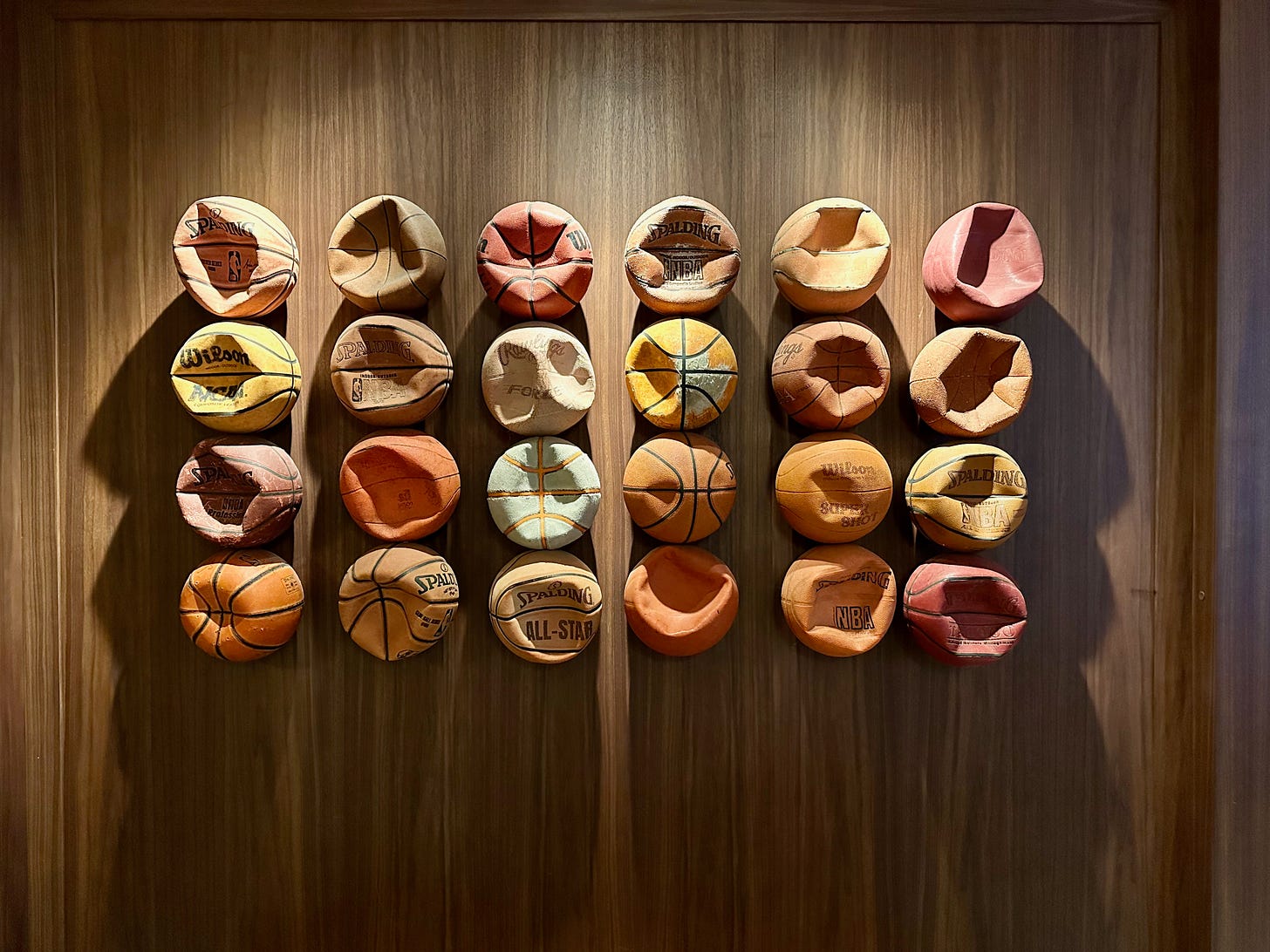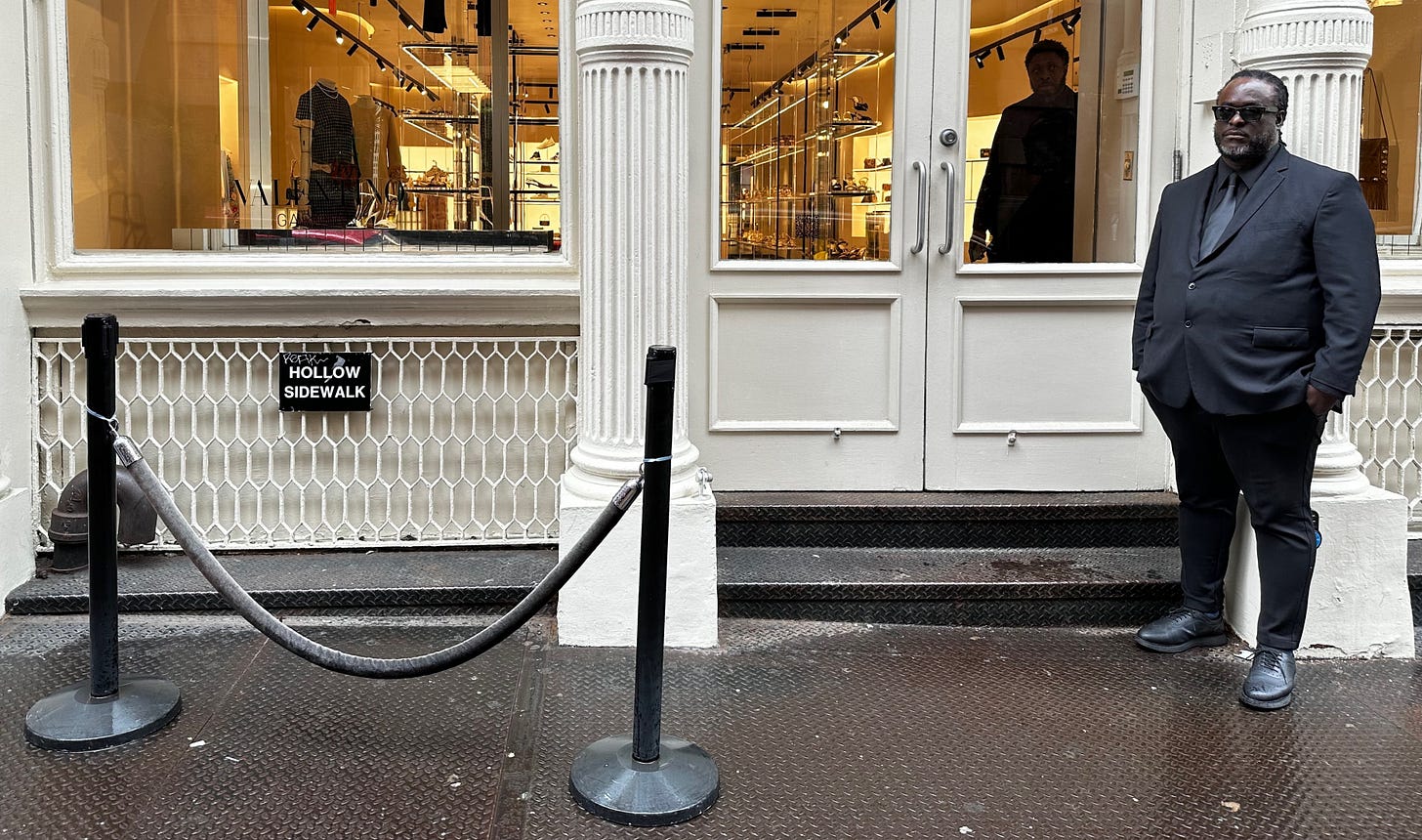Velvet Rope Retail
From nightclubs and bouncers to a growing feature in retail's most desirable streets. What, why? Queues outside stores. Plus RetailCraft podcasts, AirlineMeals and endangered Heritage Crafts. #inpo
Ropes and queues everywhere
Last month, I was trotting through Soho, NYC, in humid heat and warm rain, and I was struck firstly by the crowds (shopping and shuffling are back!) and the number of stores sporting velvet ropes and queues.
I usually stay on the Bowery, so the queues outside Supreme’s store are a familiar sight. However, from Luxury colab popups (Louis Vuitton), to workaday popups (hello Asos and Gymshark), to virtual queues outside Aime Leon Dore, and the velvet rope with iron muscle outside the luxury stores, it was queue, queue, queue.
Unlike the night club experience (where the beautiful and desirably on-trend get to jump the queue) the store velvet rope is a more egalitarian affair. Unless you know the VIP entrance, the queue is for all. What lies behind this phenomenon?
The Rise of the Velvet Rope Phenomenon
The velvet rope strategy operates on a simple but powerful economic principle: when 20% of customers provide up to 200% of profits, creating exclusive experiences for this segment becomes financially compelling. Furthermore, there’s an argument that those who are willing to wait in line are more committed purchasers once in the store. They are “high intent” and pre-qualified. However, this ignores those who sigh and walk by, or high-experience shoppers who don’t like a crush. This isn’t simple segmentation, therefore.
The psychology taps into fundamental human drivers: clustering people signal desirability; avoiding FOMO; acquiring bragging rights through exclusive access, and the social status that comes from being "inside" rather than "outside”. Research shows that perceived scarcity can increase purchase intent by up to 40%, while exclusive access programmes report sales increases of 46% and improved market visibility of 51% (2019, Monash University).
However, consumer psychology was not the origin.
Origins in New York's Streetwear Drop Culture
The commercial DNA of velvet rope retail can be traced back to Supreme's systematic approach to "drop culture." Founded in 1994 as a small NYC skate shop, Supreme's weekly Thursday drops at 11 am weren't initially designed to create exclusivity.
"The weekly drops didn't originate as a brand and marketing strategy that created hype but were instead born out of necessity because the store had a hard time keeping product on their shelves". As founder James Jebbia explained, "We'd actually have some seasons where we were sold out of the summer product at the end of March".
The anatomy of a successful drop includes limited quantities, time constraints with fixed release windows, social proof through visible queues, and community building. Supreme's evolution demonstrates this model's power - the brand was eventually acquired by VF Corp for over $2 billion.
COVID-19: The Transformation Catalyst
The pandemic fundamentally altered retail queuing. COVID-19's occupancy restrictions created natural scarcity. Many retailers were required to "alter their occupancy levels to 20%–50% of their maximum to meet social/physical distancing guidelines" (USA, source: NIH). Customers understood the reason for queuing (staying alive, limiting contagion) whether for groceries or luxuries.
An unexpected benefit for retailers was an increase in sales and profitability.
Speaking with the store manager at Aime Leon Dore last year (when I managed to gain entrance during a lull), he said that they limit store numbers to 25 people. This allows his team to provide personal service and maintain the store in a fully ‘ship shape’ fashion. They don’t filter on apparent wealth or spend, and he noted that due to the lower density and high staff:shopper ratio, a regular customer getting a $10k suit fitting could be served at the same time as a tourist buying some t-shirts. “Everyone wants space and service”, he said.
ALD operates a ‘virtual waitlist’ - you register with the door staff (who tell you whether you have a chance or not), then you can wait in the cafe or wander until called. On a weekend, their queue closes at 4.30 pm for a waitlist until 7 pm. As I left, he noted happily that ‘trading has never been better’.
Pop-Ups
The arrival of pop-up stores has also fuelled queuing as part of the experience. Short-term takeovers of empty stores met the new “marketing activation” trend. Google research in 2023 showed brands that experiment with pop-ups reporting "a 46% increase in sales, a 51% rise in market visibility and 66% greater brand awareness".
In the UK, Glossier's London pop-up "welcomed over 100,000 visitors in only 10 weeks, creating noise online amongst fans before the permanent store was opened". The format works because it creates "a sense of urgency and the illusion of scarcity among consumers". Back in NYC, we see UK brands Gymshark and ASOS running popular popups in the city of popups!
Technology and communications
Store technology integration has improved the pop-up experience, with retailers using mobile POS systems enabling transactions anywhere in the space and of course retaining customer records and capturing contact data.
In parallel, the permanent documentation of life on social channels has elevated the ‘queue selfie’ to be a regular feature in people’s streams.
Why then don’t these savvy, connected, digital consumers simply browse and buy the products online while they’re in the queue?
Part of the experience
Much of human social activity involves passing time, in good company, in ‘pointless’ pursuits - watching cricket, having a picnic, sitting at the seaside. Not rational, productive time, but time with other humans. Social time.
I remember once queuing for nearly 4 hours in 40-degree heat and stifling humidity to try the Michelin-starred Chicken Rice in Singapore. I was with the most interesting human, and the conversation is still memorable, whereas the Hawker meal is less so!
With the ubiquity of social media, you can be in the queue while sharing the experience with friends who are doing other things elsewhere. Social proof, amplification, disseminating FOMO…
Evolution
Managing store numbers without offending people is desirable, and so the acceptance by customers of the velvet rope gives retailers permission to manage flow - just make the products and experience worth the wait! The economics of increased profit from well-served, intentional customers are also attractive. The amplified “buzz” and social promotion from queuing, the adoption of time-limited or time-specific “drop” culture, and the fact that you can be in the queue and in your network’s feeds mean that time isn’t wasted.
Major city shopping is a bland array of excellence and uniformity - a shop in Soho echoes the branch in Terminal 5, Westfield or Singapore. Giving customer a time-specific, event-like reason to come to your store, commune with their network, get a great experience and spend fully. No wonder the velvet rope is in the ascendance.
The Rope.
I walked along Prince Street. The security guard is setting up a rope.
Me: What’s happening.
Him: Nothing.
I walked on.
RetailCraft podcasts
Two podcasts released recently…
The most recent is with Timo Boldt, founder and CEO of Gousto. We discuss the business's purpose, its distinct offering, and my new favourite metric: “share of stomach.” It's a short, sharp 20 minutes for your ears.
The second is with Oskar Jacobsson, Director Customer Solutions at ICA Gruppen, Sweden’s largest grocer, where we discuss the concept of their store leaders being entrepreneurs.
Both podcasts are available on Apple or wherever you get your audio.
If you have suggestions of retailers or brands to feature, just drop me a note.
Tsonduku
Tsundoku (積ん読) is the phenomenon of acquiring reading materials but letting them pile up in one's home without reading them. There are only two items on the weekend reading list this time, but I warn you that both are engrossing rabbit holes…
“The world's first and largest online photo archive of inflight meals” - AirlineMeals.net. “We've collected almost 40,000 images from more than 700 airlines from around the world”. Filter by airline, class of carriage; see the crew’s meals; peruse menus; jump back to the 1950s…
Heritage Crafts is the national charity for heritage craft skills. They maintain a directory of endangered skills in the UK, and along with the warning, they offer a lot of background and information on these skills. There is a lot to read, but I couldn’t skip over glass eye making, bell-founding (especially since I’m still sore about the closure of the Whitechapel Bell Foundry after 450 years…) or wooden fishing-net making. This list is a treasure-trove of talent, history, culture and craft - a “support it before you lose it” call to action.
Endmatter
Thanks for reading. Let me know if you have any feedback, suggestions for topics, or even contributions. In between newsletters, there is LinkedIn and Instagram, and of course, the RetailCraft podcast and RetailX analysis.
A la prochaine.





